A Comprehensive Guide for Buyers
The toilet, a key element in modern bathroom spaces, plays a vital role in hygiene and comfort. While most people take its presence for granted, the production process of a toilet is a highly sophisticated and controlled procedure, involving multiple stages of manufacturing, quality assurance, and testing. Understanding how toilets are made is not only essential for manufacturers but also highly beneficial for procurement officers, resellers, and contractors looking to invest in high-quality sanitary products. This article delves into the intricate details of the production process of toilets and outlines the key aspects that buyers should consider when purchasing these essential products.
1. Raw Material Selection
The first step in toilet production is choosing the right raw materials. Most toilets are made from vitreous china, a type of ceramic material that provides durability, a smooth finish, and water resistance. The primary ingredients for vitreous china include:
- Clay: Acts as the foundation for the ceramic structure.
- Silica: Adds strength and thermal resistance.
- Feldspar: A mineral that assists in melting the clay during the firing process.
- Kaolin: A white clay that improves the smoothness and workability of the mixture.
These raw materials are mixed with water to form a slurry, also known as slip. The consistency and purity of this mixture play a crucial role in the overall quality of the final product. Variations in material quality or mixing ratios can affect the structural integrity of the toilet.
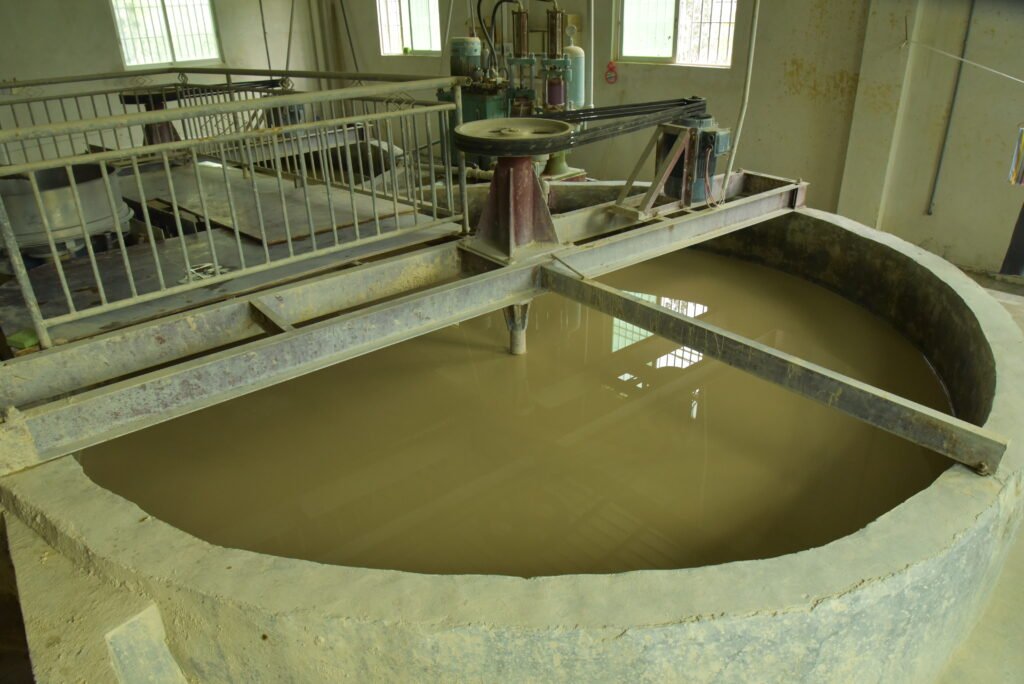
2. Molding
Once the raw materials are prepared, the slurry is poured into molds to give shape to the toilet. The molds are typically made of plaster because plaster absorbs water from the slip, allowing the ceramic material to form a solid shape. The toilet molds come in multiple parts to create the distinct shapes for the bowl, cistern, and other components.
During the molding process, special attention is given to ensuring uniform thickness and proper adhesion of all parts. The drying time is a critical factor; if the mold is removed too early, the toilet may become deformed. After partial drying, the product is removed from the mold and additional features, such as the drainage channels and mounting holes, are manually shaped and refined.
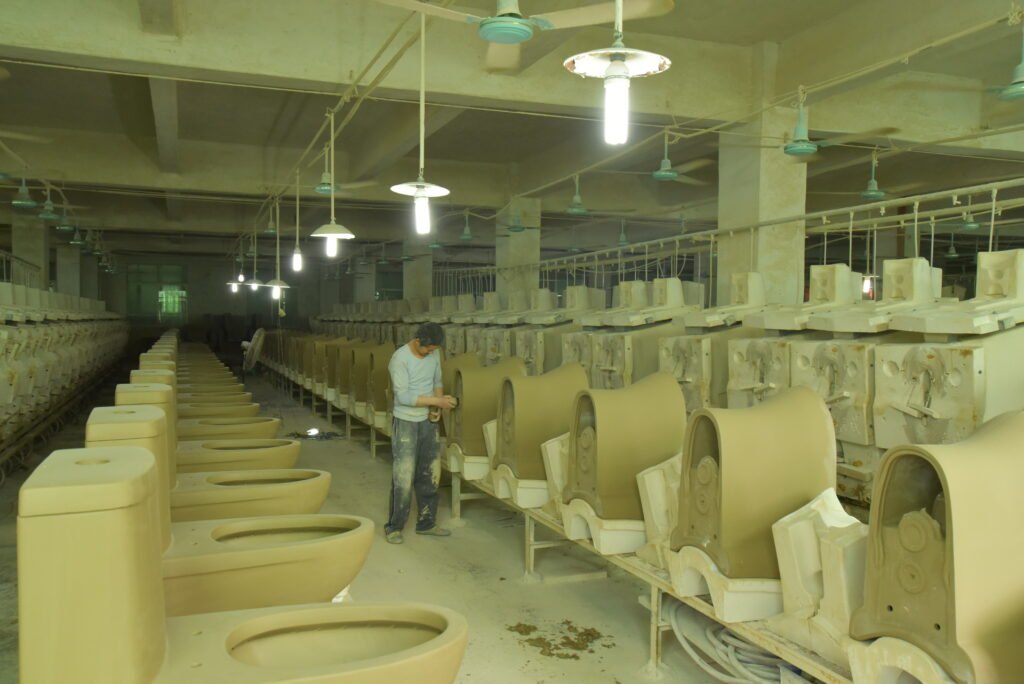
3. Drying
After molding, the newly shaped toilets undergo a drying process to remove excess moisture. This step is crucial as residual moisture can cause the toilet to crack or warp during the firing stage. The drying process usually takes place in a controlled environment with specific humidity and temperature settings.
Depending on the production scale and type of product, drying can take anywhere from several hours to several days. Some manufacturers use automated drying chambers that accelerate the process, while others may rely on natural air-drying methods.
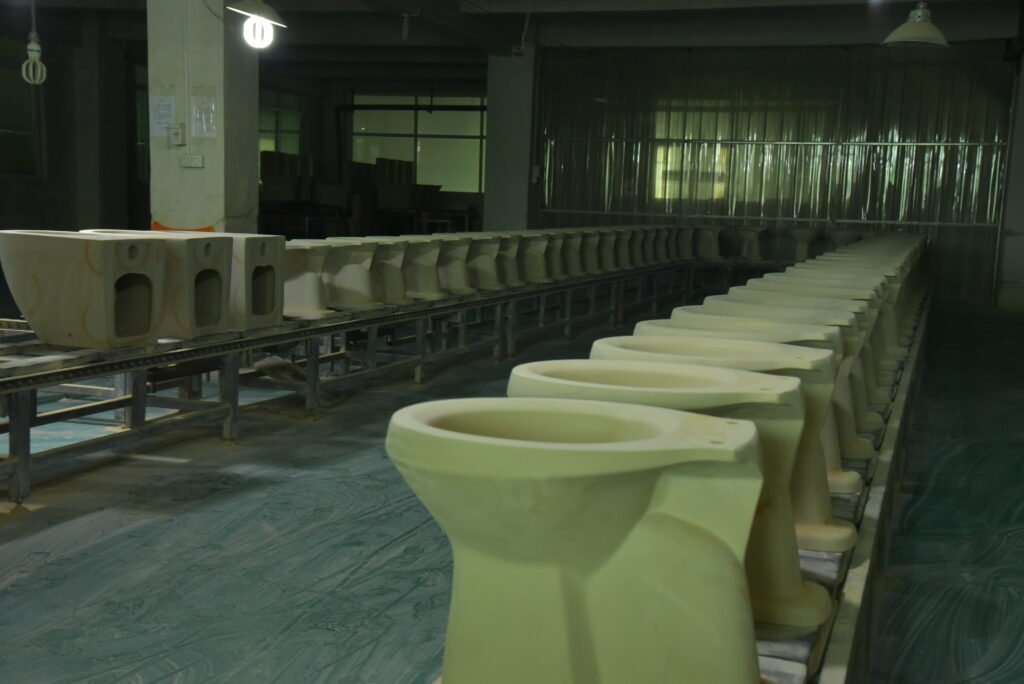
4. Glazing
The next step in the production process is glazing. Glazing is the application of a glass-like coating that provides the toilet with its glossy finish and waterproof properties. The glaze also serves to protect the toilet from stains, bacteria, and moisture damage. The glazing process typically involves the following steps:
- Preparation of the Glaze: The glaze is usually a mixture of various minerals and pigments. It is prepared in a liquid form and adjusted to a specific viscosity.
- Application: The glaze is applied either by spraying or dipping the toilet into a glazing solution. Spraying is generally preferred as it allows for more even coverage, but dipping may be used for smaller components.
- Drying the Glaze: After the glaze is applied, the toilet is allowed to dry for a short period before proceeding to the firing stage.
The quality of the glaze application is critical. Any inconsistencies or imperfections in this stage may affect the toilet’s final appearance and durability.
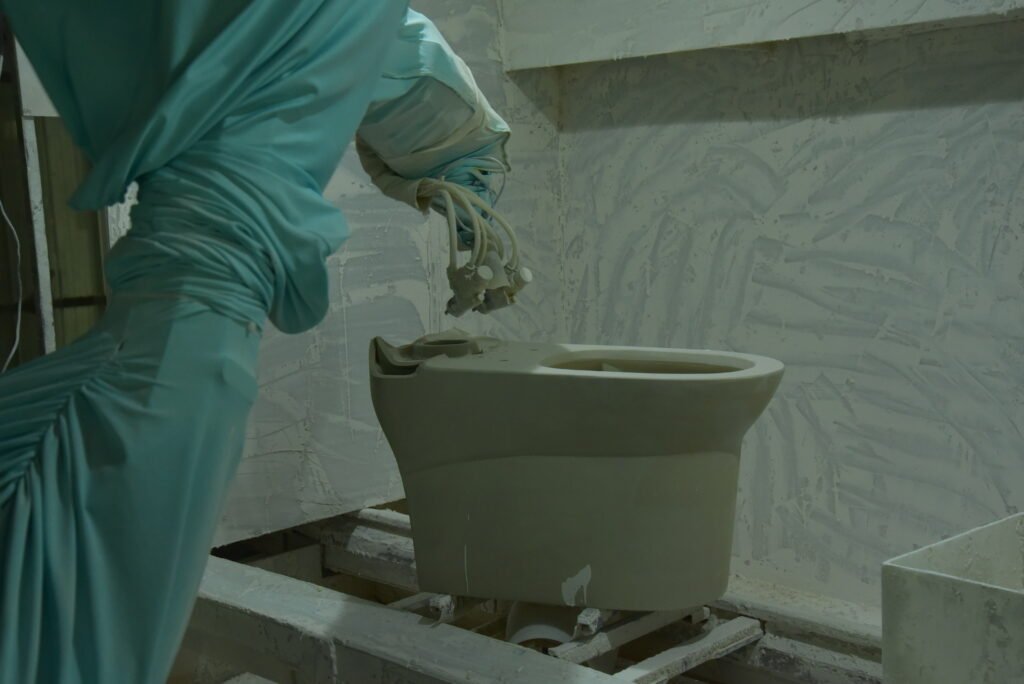
5. Firing
Firing is one of the most crucial stages in the production of toilets. The glazed and molded toilet is placed in a kiln, where it is fired at temperatures ranging from 1200°C to 1300°C. This high-temperature firing process vitrifies the clay, turning it into a durable, non-porous ceramic material.
The firing process is carefully monitored, as variations in temperature or firing time can cause defects such as cracks, warping, or incomplete vitrification. The uniformity of heat distribution within the kiln is also vital to ensure that each toilet is fired evenly.
In some cases, the toilet may be subjected to a second firing to enhance the glaze’s finish or to add decorative details. The outcome of this stage directly impacts the product’s strength, longevity, and aesthetic appeal.
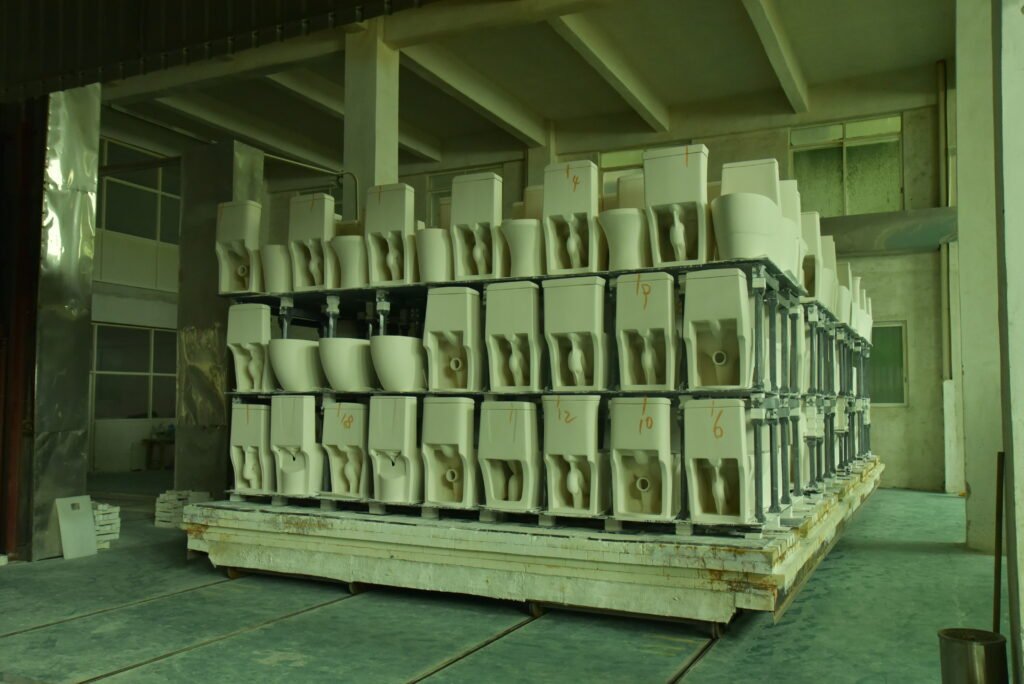
6. Quality Control and Inspection
Quality control (QC) plays an integral role throughout the entire production process, but particularly after the firing stage. At this point, toilets undergo rigorous testing to ensure they meet industry standards and customer expectations. QC teams focus on the following aspects:
- Visual Inspection: The toilet is examined for any visible defects, such as cracks, glaze inconsistencies, or deformation.
- Dimensional Checks: The toilet’s dimensions are measured to ensure that it adheres to the specified design requirements, particularly in terms of bowl size, height, and outlet placement.
- Water Absorption Tests: A low water absorption rate is critical for ceramic toilets. Products with high absorption rates may suffer from bacterial growth, odor retention, and structural weaknesses.
- Weight Test: The weight of the toilet is measured to ensure it corresponds to the designated product category.
- Load-Bearing Tests: Toilets are subjected to weight-bearing tests to assess their structural integrity and ensure they can handle the average weight of users.
- Flushing Performance: One of the most crucial functional tests is the flush performance test, where water consumption, flushing efficiency, and drainage speed are evaluated.
Only toilets that pass these quality control tests proceed to the packaging stage. Products that fail to meet standards are either recycled or discarded.

7. Assembly and Packaging
After passing quality checks, toilets are assembled with additional components, such as the seat, flushing mechanism, and other hardware. The toilet seat is typically made from high-quality plastic or wood, while the flushing mechanism consists of various parts like the fill valve, flush valve, and lever. These parts are either produced in-house or sourced from specialized suppliers.
Once assembled, the toilets are carefully packaged to prevent damage during transportation. Packaging materials may include foam padding, cardboard boxes, and plastic wraps. Proper labeling and barcoding ensure traceability and simplify the logistics process for large-scale orders.
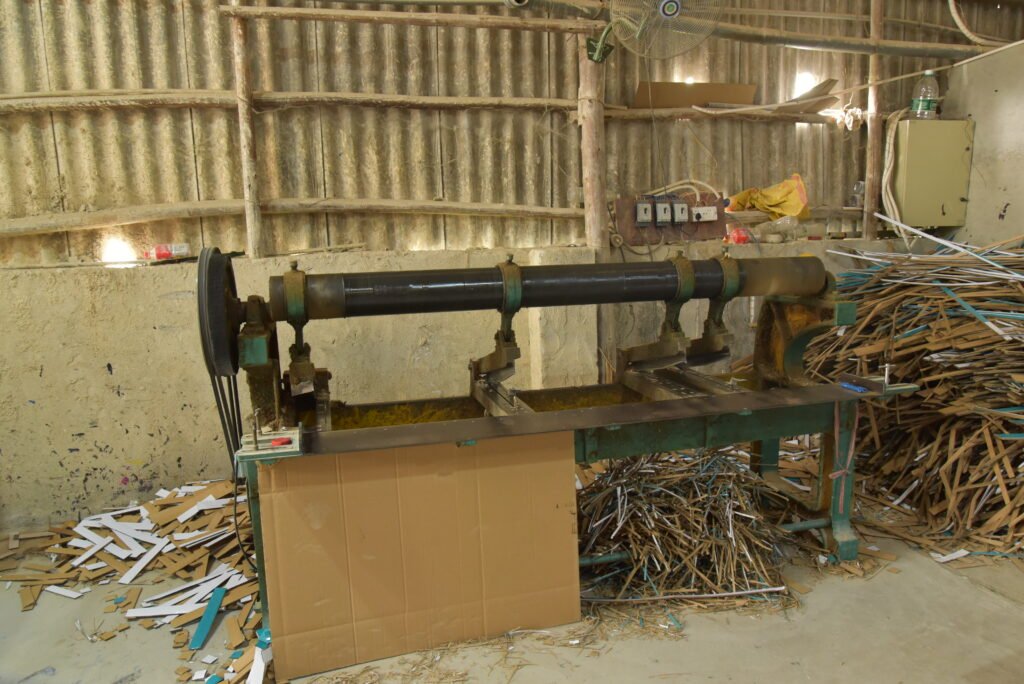
8. Transportation and Delivery
Transportation of toilets is a delicate process due to the fragile nature of the ceramic material. Special care is taken to minimize the risk of damage during transit. Shipping is often done via container trucks, but international orders may require sea freight. During transportation, pallets and crates are often used to ensure the safe stacking and loading of products.

Key Considerations for Buyers
When procuring toilets, there are several important factors that buyers should keep in mind:
1. Quality and Durability
The longevity of a toilet depends on the quality of materials used and the precision of the manufacturing process. Buyers should prioritize products that undergo rigorous testing, including water absorption and load-bearing assessments. Requesting detailed product specifications and certifications from the manufacturer can help in verifying quality standards.
2. Flushing Efficiency
Flushing performance is one of the key functional aspects to consider. Low-consumption toilets that efficiently remove waste while minimizing water usage are highly sought after, especially in regions facing water shortages. Buyers should look for products with high flush ratings or certifications from recognized bodies, such as the WaterSense label in the United States.
3. Design and Compatibility
Toilets come in various designs, including one-piece, two-piece, wall-mounted, and floor-mounted models. The design choice depends on factors like installation space, aesthetics, and plumbing requirements. Buyers should ensure that the toilet design fits their specific project needs and is compatible with local plumbing standards.
4. Eco-Friendly Features
With increasing awareness about environmental sustainability, many buyers prefer toilets that offer eco-friendly features. Dual-flush toilets, low-flow models, and products made from recycled materials are gaining popularity. Additionally, many manufacturers are focusing on reducing the carbon footprint of their production processes.
5. Price vs. Value
While price is an important factor, it should not be the sole determinant of purchasing decisions. Higher-priced products may offer superior durability, water-saving features, and extended warranties. Buyers should weigh the long-term benefits against the initial cost to ensure they are getting the best value for their investment.
6. Supplier Reputation
Working with reputable suppliers ensures product quality and timely delivery. Buyers should conduct due diligence by researching suppliers’ production capabilities, customer reviews, and compliance with international standards. Establishing a good relationship with suppliers can also lead to better after-sales support and bulk order discounts.
Conclusion
The production of toilets is a complex and meticulously controlled process, requiring high-quality materials, precision engineering, and rigorous testing. For buyers, understanding this process can provide valuable insights into the product’s durability, functionality, and overall value. By focusing on critical factors like material quality, flushing efficiency, and supplier reputation, procurement officers can make informed decisions, ensuring they purchase reliable and efficient toilets that meet both consumer needs and industry standards.
